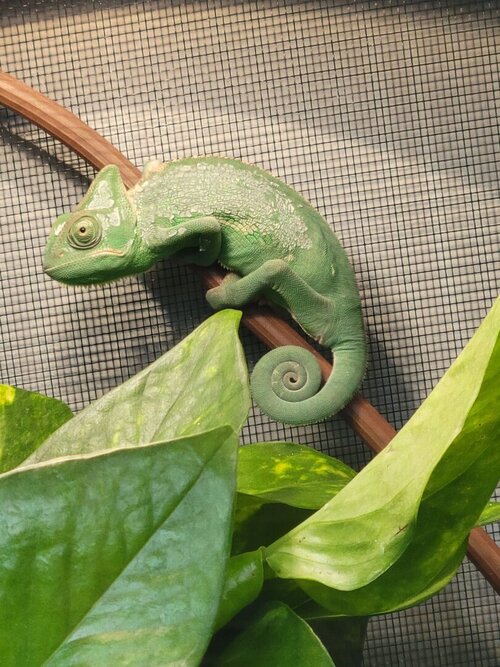So I have talked to a few people on here about my chameleons shed. She has shed everything except for one side of her body and part on her head. I have looked into what to do and neptunethechameleons video said to leave everything the exact way it is. They are dry shedders. But once it's been over a week then look into it. It has been about a week now and nothing has changed. I'll send pictures but I just wanna help. Anything I can do?
Navigation
Install the app
How to install the app on iOS
Follow along with the video below to see how to install our site as a web app on your home screen.
Note: This feature may not be available in some browsers.
More options
You are using an out of date browser. It may not display this or other websites correctly.
You should upgrade or use an alternative browser.
You should upgrade or use an alternative browser.
Shed
- Thread starter 2134bean
- Start date
Mendez
Chameleon Enthusiast
With a veiled chameleon, you can safely aim for about 30-50% humidity during the day. Since you are doing the naturalistic hydration schedule, you will want to reduce the nighttime humidity levels. At night, aim for about 80% humidity. This should reduce the daytime humidity levels with less water in the air while giving your cham enough humidity/water to stay healthy and hydrated at night and dry out during the day.
Often times when people reach 100% humidity, they are putting more water into the air than precisely 100% humidity. The hygrometer can only tell you when you have reached 100% humidity, not when to stop misting/fogging. I would only recommend people aim for 90-100% humidity if they have a dehumidifier or live in a very low humidity environment that dries out the cage during the day down to 30-50%.
In sum, aim for about 80% at night. This should allow for sufficient hydration while allowing your cham to dry out and have a nice and healthy shed during the day. Less humidity put into the air at night means that there will be less humidity in the air during the day.
Often times when people reach 100% humidity, they are putting more water into the air than precisely 100% humidity. The hygrometer can only tell you when you have reached 100% humidity, not when to stop misting/fogging. I would only recommend people aim for 90-100% humidity if they have a dehumidifier or live in a very low humidity environment that dries out the cage during the day down to 30-50%.
In sum, aim for about 80% at night. This should allow for sufficient hydration while allowing your cham to dry out and have a nice and healthy shed during the day. Less humidity put into the air at night means that there will be less humidity in the air during the day.
Alright so if I try to alter my humidity levels should that help with her shed? My temperature also stays around low 80s or high 70s during the day and 60-70 during night. I live in alabama so it's hard to keep it cool. Any other tips?With a veiled chameleon, you can safely aim for about 30-50% humidity during the day. Since you are doing the naturalistic hydration schedule, you will want to reduce the nighttime humidity levels. At night, aim for about 80% humidity. This should reduce the daytime humidity levels with less water in the air while giving your cham enough humidity/water to stay healthy and hydrated at night and dry out during the day.
Often times when people reach 100% humidity, they are putting more water into the air than precisely 100% humidity. The hygrometer can only tell you when you have reached 100% humidity, not when to stop misting/fogging. I would only recommend people aim for 90-100% humidity if they have a dehumidifier or live in a very low humidity environment that dries out the cage during the day down to 30-50%.
In sum, aim for about 80% at night. This should allow for sufficient hydration while allowing your cham to dry out and have a nice and healthy shed during the day. Less humidity put into the air at night means that there will be less humidity in the air during the day.
Mendez
Chameleon Enthusiast
Yep, lowering your humidity at night should allow for a dryer day which will help her shed. Temps sound good. Basking should be between 80-85F (though make sure you measure the temperature at the back of the chameleon because veiled chams are notorious for getting burns or their casques--though shouldn't be too much of a problem since you have a female with a smaller casque size than males). The ambient should be in the low to mid-eighties. Nighttime temps should preferably get under 65F though people have successfully kept them at higher nighttime temps. The cooler the better. They have evolved over a long period of time to take montane nighttime temperatures so I try not to fight against evolution too much by providing warmer temps than their natural environment.Alright so if I try to alter my humidity levels should that help with her shed? My temperature also stays around low 80s or high 70s during the day and 60-70 during night. I live in alabama so it's hard to keep it cool. Any other tips?
Well I always gutload my insects with mustard greens and good fruits like oranges and apples, rep-cal calcium with no d3 every day except Mondays and on every other Mondays I alternate between rep-cal calcium with D3 and Reptivite. I like to feed crickets, super worms, dubia roaches, and waxworms. I've been told I need to add more variety so my next insect order will have more options to eat from.What vitamin supplement do you use? What's the source of vitamin A in it?




